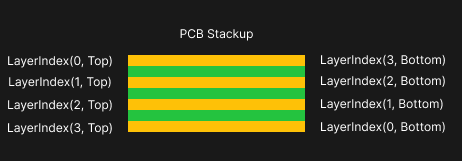LayerIndex
The LayerIndex type is used to specify which conductor layer in the board stackup that a particular statement or property affects.
Outline
defstruct LayerIndex :
index:Int
side:Side
defn LayerIndex (index:Int, side:Side = Top) -> LayerIndex:
...
The LayerIndex type expects two arguments:
index- If we consider the conductor layers in board stackup an zero-indexed array, theindexis the offset into the array from either theTopor theBottom.side- This parameter determines whether theindexapplies from theTopgoing down, or from theBottomgoing up.
Symmetry of Top and Bottom Indices
The Bottom side indices can be considered a reverse indexing scheme.

Notice that there is a way to index every layer in the stackup in either direction.
Shortcuts based on Side
In some applications of the LayerIndex type, you will often see the type LayerIndex|Side used. This means that the user can pass either a LayerIndex or a Side parameter in the form of Top or Bottom enumerated values.
These Side values are a shortcut for:
Top=>LayerIndex(0, Top)Bottom=>LayerIndex(0, Bottom)
Operators
Currently the plus and minus operators are defined for the LayerIndex and Side types. This provides a short cut for indexing:
val inner-1 = Top + 1
println("Inner 1: %_" % [inner-1])
val inner-N-1 = Bottom - 1
println("Inner N-1: %_" % [inner-N-1])
val inner-skip = inner-1 + 2
println("Inner Skip: %_" % [inner-skip])
When run this will generate:
Inner 1: LayerIndex(1)
Inner N-1: LayerIndex(1, Bottom)
Inner Skip: LayerIndex(3)